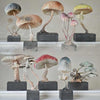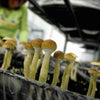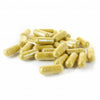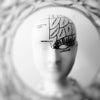Trippy Art, Drawings & the Psychedelic Influence on Human Expression.
Trippy Art, Drawings & the Psychedelic Influence on Human Expression.
Psychedelics have long been used as a catalyst for creativity, from the ancient Greeks who wrote about the power of mushrooms to "inspire" the Muse to today's modern day artists who we will discuss and showcase in this article. Psychedelics have been used in the creation of art throughout history and are still being used to this day.
Psychedelic art is a very common form of art that can be found around the globe, it is used to express oneself in different ways to those who enjoy the beauty of trippy visuals. Psychedelic Art can range from paintings, photography, illustrations, street art, installations, you name it and someone has probably created it with the use of hallucinogens.
Psychedelic art has been around since the 60s. This art often depicts life-changing experiences seen through the eyes of artists who have used psychedelic drugs such as LSD, psilocybin (Magic Mushrooms) and Mescaline. It is believed that these types of substances are powerful enough to stimulate creativity, open up the mind to new creative ideas and make it easier for people to express themselves through art. In some cases, this may be true as some works of psychedelic art look like they were painted by a mad man in a drug induced state. Some even feature strange creatures and objects that would be impossible to paint without having been on a psychedelic trip at some point in your life. Some of these paintings are truly amazing and look very trippy indeed! However, it is important to remember that just because someone has had a psychedelic experience, doesn't mean that their paintings are going to be any good. Even so, there are many examples of psychedelic art that is truly beautiful and captivating. So what exactly is it that makes this type of art so interesting?
What causes people to get artistic inspiration from their psychedelic experiences?
Firstly, it should be said that not all psychedelic artists were drug addicts or people who abused drugs recreationally. Some did take psychedelics on purpose with the intention of using them as an aid for slowing down their thinking process so they could gain a deeper understanding of themselves and the world around them. Others used them as an aid for their spiritual quests or simply because they enjoyed the effects too much! Even so, it is true that many people experienced profound changes in their perspective on life after taking psychedelics. As a result, some people say it was easier for them to express certain emotions or thoughts through art when under the influence of these substances than when sober! It's not hard to see why. After all, most people find it difficult to think straight when drunk or high on illegal substances. This can also be said about being under the influence of psychedelics too! It is very possible that this can cause some people to feel more relaxed and calm which may help with producing creative work especially if you normally suffer from anxiety issues or stress related disorders such as depression or PTSD (Post Traumatic Stress Disorder). Many people report feeling more confident about their ability to create beautiful work while under the effect of hallucinogens too! These positive effects can last long after the trip itself has ended which may explain why many artists choose to use these substances again in order to help them produce better work! Read next – The benefits and risks associated with ayahuasca use for creative purposes!
History Of Trippy Art
The history of psychedelic art dates back thousands of years where we can find evidence of early cave paintings with hallucinogenic properties that people used for spiritual practices. As time progressed and the use of psychedelics grew so did the creativity of those who consumed these substances. The 1960s saw an explosion of psychedelic artwork and continues to this day with new artists making their mark on the world.
Psychedelic art is usually created by those who use psychedelic drugs, or they create their art while under the influence of psychedelic substances. The use of psychedelics allows artists to tap into a different part of their mind to create something truly unique that would not be realized without an altered state of consciousness, and this is how psychedelic art is born.
We will look at some famous artists who have created some psychedelic masterpieces, the different types of trippy art and how psychedelics created a new generation of artistic masterpieces.
Psychedelic art is not just paintings, it can be created in many different mediums.
Cave Painting Artwork- The oldest form of psychedelic art is cave art that was used for spiritual purposes thousands of years ago. These are paintings that were done with the use of hallucinogens such as mushrooms, which contain psilocybin and other psychoactive substances. The paintings were created using very basic tools and depicted animals, humans and human like figures. Some of these paintings have been dated back to over 10,000 years ago! See below for examples of cave art with psychedelic properties:
Stonehenge- Stonehenge is one of the most famous pieces of psychedelic artwork in history because no one really knows how it was built! This prehistoric monument had been erected around 5,000 to 4,000 BC and was thought to be used for a variety of reasons including a burial site, an astronomical calendar or a temple. It is still unknown how this structure was built without modern day machinery but there are theories explaining how it could have been accomplished by some groups in history, including extraterrestrial beings! Below is a picture taken at Stonehenge showing psychedelic properties that seem to be alive:
Ancient Egyptian Art- The Ancient Egyptians were known to take psychedelic substances mainly mushrooms and most likely peyote, which they would use for spiritual purposes. They also used plants that contained DMT as a catalyst for their artwork. Their art is very psychedelic in nature and usually depicts religious figures and gods in trippy visuals that are still being discovered to this day. Below are some examples of ancient Egyptian art that shows the use of psychedelics:
Medieval Art- During medieval times many artists were known to consume psychedelic mushrooms as a way to gain inspiration for their artwork. Many of these artists produced works of art that were truly out of this world. This was also the time when street art was used as a way to spread messages and protest against the ruling class, which led to many people being persecuted for their work. Below are examples of medieval psychedelic artwork:
Modern Day Psychedelic Art- There is no shortage of creative artists who continue to produce new works of art with the use of different substances including LSD, DMT, Psilocybin, Cannabis and Peyote just to name a few! Artists have continued to build upon the foundations laid by those before them in order to create pieces that people can enjoy forever. Some modern day artists include Alex Grey, Robert Venosa, Annie Oak, Shonagh Adelman, and more!
Psychedelic art can be found all over the world and is usually produced by artists who use psychedelic substances in some form. There are many ways to create psychedelic art, and it is very subjective to the creator. It can be paintings, photography, street art, mixed media or any combination of mediums that you can come up with. You need not be an artist to produce psychedelic artwork, as anyone can do it!
What is Trippy Psychedelic Art?
"Psychedelic Art focuses on creating an altered state of consciousness through the use of psychedelics" Psychedelics have been used for thousands of years and continue to be used by people around the globe for spiritual purposes. One of the most common ways that people use psychedelics is in the creation of artwork as a way to express one's deepest feelings and emotions. Artists have long used psychedelics as a catalyst for their work and continue to do so today.
The purpose of psychedelic art is not only to create mind boggling visuals but also to create a feeling that goes along with the piece. Some people prefer certain types of pieces such as paintings while others may like sculptures or even mixed media pieces. The intention behind the piece is important because it will determine whether or not it will leave an impact on those who view it. If an artist creates a piece without intention behind it then they will never be able to communicate what they want their viewers to feel when looking at their art. This is why creativity is key when producing psychedelic artwork.
When producing your own psychedelic artwork you do not necessarily need to make something that looks good, you want your piece to resonate with those who view it in some way or another. If you are unsure how your art will resonate with others then ask someone else what they think it means or how they feel about it before committing more time into working on a piece that may never amount to much. Asking for feedback on your work will help you see where you need improvement but should be done sparingly because everyone has different tastes and opinions on artwork, especially if you are producing something that uses psychedelics!
Who uses Psychedelic Artwork?
Anyone can create psychedelic artwork as long as they have something meaningful to express through it! Artists across the globe continue to produce new works of art every day using different mediums and substances as a catalyst for their creations. Some well known artists include Alex Grey, Robert Venosa, Annie Oak and Shonagh Adelman just to name a few! Most modern day artists now use digital mediums such as Photoshop in order to produce their works but there are still those who stick with traditional methods such as painting or sculpture by hand. The choice is yours when deciding how you want produce your art but either way there are unlimited possibilities when creating something unique! The use of psychedelics allows artists to tap into a different part of their mind which leads them down a path towards great creativity! Artists can choose from many different types of psychedelics including LSD, DMT (Ayahuasca), Psilocybin Mushrooms (Magic Mushrooms), Cannabis and Peyote just to name a few! The choice is yours but remember that if you consume too much then you may experience unwanted side effects such as nausea which could ruin your masterpiece! Psychedelic substances such as LSD can also lead some users into psychosis if taken in large amounts so caution should be exercised when deciding how much should be consumed for maximum creative output! It's better too little than too much when it comes down to psychedelics because once "the door closes" there's no going back until it wears off completely, which can take anywhere from 6-12 hours depending on dose etc..
Famous Trippy Artists with a Psychedelic Influence
Most people know that some of the greatest psychedelic artists such as Andy Warhol and H R Giger used psychedelics at some point in their lives. However, there are many more that did too including Salvador Dali, Rembrandt and Pablo Picasso. Even so, it is believed that these artists didn't use psychedelic drugs to help them paint better or more creative work. Instead, it is believed that they used them for other reasons such as to enhance their spiritual journeys, alter their state of mind in order to relieve stress or anxiety issues and even for recreational purposes! Although we may never know exactly why all of these people took psychedelic drugs or exactly what effects they had on their work, it's safe to say that some of the most creative works in history were produced by people who have taken psychedelics at some point in their lives! In fact, most artists who have produced great works of art probably took psychedelics at some point during their lives whether they knew about it or not! Read next – 6 reasons why you should try ayahuasca!
Picasso once said; "Every act of creation is first an act of destruction." This is very true in the case of psychedelic art and can perhaps help explain why artists who take psychedelic drugs sometimes create some truly amazing works of art!
Alex Grey
Alex Grey is a contemporary American artist, author and founder of the Chapel of Sacred Mirrors (CoSM) which is an art sanctuary housing his visionary artwork. Alex Grey is best known for his paintings of "alchemical and religious themes, pop culture imagery, scientific motifs, historical images, and erotic renderings." Alex Grey's art reflects his spiritual vision. His humanistic approach to the world is presented in the context of what he calls "visionary art." Grey believes that through art we can experience a "sacred view" that reveals our true nature as creative beings who are connected to the sacred. "I want to open people's hearts and minds to possibilities beyond what they think they know." Grey's artwork has been exhibited throughout the world including solo exhibitions at premier institutions in Europe, Asia, South America and North America. His work is included in collections such as the Yale University Art Museum, Spencer Museum of Art at the University of Kansas, Museum of Modern Art in New York City, The National Library of Medicine in Washington DC, The British Museum and many others. His paintings have inspired multi-platinum albums by Tool & System Of A Down. His artwork is included in the book Alex Grey: The Chapel Of Sacred Mirrors by Daniel Pinchbeck. He has appeared on national television shows such as Good Morning America and MTV. He has also been featured in documentaries such as The Omega Factor produced by James Redfield. His work has been published extensively—including features in Rolling Stone, Psychology Today, U.S. News & World Report, New York Times Magazine, USA Today, Los Angeles Times Magazine and many more publications worldwide.
Bob Ross
The Joy of Painting' is a well-known TV show created and hosted by Bob Ross. If you haven't seen this show before, you definitely know his work. He was a great artist who used psychedelics to fuel his creativity and make truly amazing art. Bob Ross, better known as The Painter of Joy, was a very influential artist who changed the face of the art world with his unique style of painting. Bob Ross has been on television for over 30 years, his show 'The Joy of Painting' is still being produced and is available on Netflix and Youtube. Bob Ross used psychedelic mushrooms to fuel his creativity and make some of the most iconic paintings used by people all around the world. Bob Ross was a big supporter of psychedelic mushrooms and they played a large role in his career as an artist. He painted many pieces of art that depicted mushrooms and their role in life. Mushrooms have been used by Bob Ross since 1979 and were a big inspiration for him and his art. 'The Secret of the Magic Mushroom' was a TV show hosted by Bob Ross in which he discussed the benefits of magic mushrooms and their role in life. He taught viewers about how to create psychedelic paintings and he made sure to always keep them around him while he was painting. He was also known for having mushrooms around him while he was painting in many of his TV appearances. His use of psychedelics helped make him an extremely successful artist and he credits them for his career and success. His paintings are still very popular today and continue to inspire thousands of artists around the world.
Salvador Dali
Salvador Dali was one of the most influential painters of all time, he created some of the best and most iconic paintings in history that are still being studied today. He had an extremely unique style of painting that no one else can replicate, but many have tried to. Salvador Dali used psychedelic mushrooms as a catalyst in his art and a way to tap into his subconscious to create some truly amazing pieces of artwork. Salvador Dali was born on May 11th, 1904 in Figueres, Spain. He began painting at a young age but it wasn't until he had his first psychedelic experience that everything changed for him. Salvador Dali experienced his first psychedelic mushroom trip at the age of 22, after this experience he decided to use them as a way to tap into his subconscious mind. Salvador Dali always had a fascination with art, but it wasn't until he took psychedelic mushrooms that he saw how truly magical it can be. Dali became an active member in the psychedelic community and was known to distribute magic mushrooms to friends and other artists he knew. He also experimented with other psychedelics such as LSD and peyote. Salvador Dali is known worldwide as one of the greatest artists to ever live, he has continued to inspire countless artists throughout history and is still an inspiration to many artists around the globe today. His work is still being studied and has inspired many artists from all over the world. Salvador Dali's paintings are well known throughout the world, he created some truly amazing works of art that can still be seen today, albeit in museums around the world since they are worth millions. Salvador Dali's artwork still inspires us today to try new things and imagine new possibilities, something that we may not have been able to do without psychedelics. His artwork is truly amazing and has inspired many artists over the years, his use of psychedelics played a huge role in his success as an artist and helped create some truly unique paintings that will never be forgotten.
Types of Trippy Art
There are many different types of trippy art that have been created over the years, artists have used psychedelics to fuel their creativity and make some truly amazing pieces of work. Here are some examples of trippy art from around the world. Painting Painting is one of the oldest forms of art that has been used by humans for thousands of years. It is a very common form of art that we see every day, but not everyone knows about psychedelic painting. There are many different ways to create psychedelic paintings, from using watercolours to oil paints or even acrylics.
Artists have also used different mediums such as chalk, pencil crayons or pastels to create trippy paintings. The possibilities are endless when it comes to creating a painting and there is no right or wrong way to do it, it all depends on what you enjoy and what your goal is with your creation. Artists from around the world use psychedelics as a catalyst for their creativity in order to make some truly unique pieces of artwork. This article will showcase some examples of beautiful psychedelic paintings made by artists who use psychedelics as a catalyst for their creativity.
Illustration can be found in all forms of media including books, music albums, magazines and even online websites like this one! Illustration is a very popular style that can be seen throughout history and continues to this day with new artists creating new masterpieces every single day. Illustrators have always had a fascination with trippy visuals and they continue to inspire artists today with their great works of art. Illustrators have used psychedelics throughout history as a way to express themselves through visual means and now we will showcase some amazing illustrations made by artists who love trippy visuals just as much as we do!
Why does this kind of art seem so trippy?
When looking at an image or painting that was created while the artist was on a drug trip, it is very easy to see how someone could describe this as trippy. Many images created by people under the influence feature strange creatures and objects which can be hard to decipher. For example, many pictures painted by Salvador Dali are known for featuring melting clocks and freaky looking faces which look nothing like a real human face would. It is also possible that when looking at these types of images that appear to be chaotic messes up close, our brain may try to make sense out of them by making connections between certain shapes or forms which aren't really there! However, you may disagree with this theory if you have ever seen a painting done by someone high on LSD before because many paintings done while under the influence don't really look much different from those done while sober. It's hard to tell whether someone was high on LSD when they were creating their work just from looking at one painting by itself. The main way you could tell would be if the artist talked openly about using LSD which isn't always easy to do either because most people don't like talking about using illegal substances!
In conclusion, there is no doubt that psychedelic drugs can have a positive effect on the world of art and even if many people do not feel this way, it is still true that many artists have used LSD, psilocybin (Magic Mushrooms) and Mescaline in order to help them come up with new ideas for their paintings. Some artists also report feeling more confident about their work and their ability to produce it while under the influence of psychedelics.







Leave a comment
Please note, comments must be approved before they are published